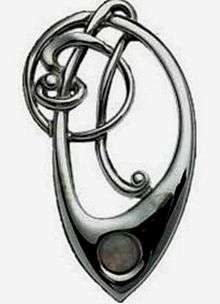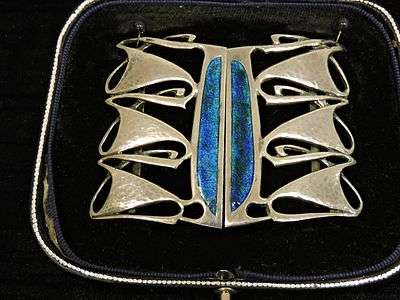Archibald Knox (designer)




Archibald Knox (9 April 1864 in Cronkbourne[1] near Tromode, Isle of Man[2] – 22 February 1933 in Braddan), was a Manx designer of Scottish descent. His pioneering and prolific work bridged the Arts and Crafts Movement, Celtic Revival, Art Nouveau, and Modernism.[3][4] He is best known as being Liberty's primary designer at the height of their success and influence upon UK and International design[5] (to the extent that in Italy, Art Nouveau was known as Stile Liberty).
Knox's father, William Knox, was living in Kilbirnie when he married Ann Carmichael from Lismore Island in 1853. They had moved to the Isle Of Man in 1856 with their firstborn, Robert where William "an exceptionally ingenious cabinet and machine-maker, joined Moore’s Tromode Works, makers of high quality herring nets and sailcloth."[6] William's sister Margaret had been the first Knox to move to Man when she married a Manx fisherman, William Callister in 1856. William Knox later started his own firm "William Knox’s Engineering Works" and was joined in his enterprise by four of his sons - Archibald pursuing his own career in art. Besides running a successful steamboat and ferry business, the Knox family were pioneers in industrial electric lighting on Man and introduced the first motor car to the island. Knox's engineering background may have influenced his design process in that his metalwork designs were produced in the style of ready-to-engineer blueprints.
Archibald, the Knoxs' 5th child (and 5th son), started his schooling at St. Barnabas Elementary School, and later attended Douglas Grammar School and Douglas School of Art, developing a lifelong interest in Celtic art, particularly the carved Celtic and Norse stone crosses on the Isle of Man,[7] which date from c.500AD to c.1200AD.
Knox's hundreds of designs for Liberty's made his style widely known,[8] (though not his name, as Liberty's kept their designers anonymous) as did his watercolours, graphic designs and fonts. His design talent covered a wide range of objects, ornamental and utilitarian, and included silver and pewter tea sets, jewellery, inkwells, boxes, gravestones and even bank cheques,[9] much for Liberty's Tudric (pewter) and Cymric (precious metals) ranges. The gravestone of Liberty's founder, Arthur Lasenby Liberty, was designed by Knox.
In 1897 he started teaching at Redhill School of Art where his friend A.J.Collister was principal, leaving with him for the Kingston School of Art in 1899. In 1913 he spent a year in the United States, and on his return to Man acted as a censor of internees' letters during World War I. After the War he again took up teaching art at some of the Isle of Man's schools until his death. Knox also produced a variety of design work on the Island for publications, illuminations, and gravestones.
Knox's great late work was an illuminated manuscript 'The Deer's Cry'. Each page is a complex interlaced illumination of a line of the prayer known as 'The Deer's Cry' or 'St Patrick's Breastplate'. The style and imagery of each page reflects the content of each line of the prayer.
Knox died of heart failure in 1933 and was buried in Braddan Cemetery. His epitaph reads "Archibald Knox. Artist. A servant of God in the ministry of the beautiful"
To celebrate the 150th Anniversary of Knox's birth, the Isle of Man Post Office issued a set of 10 stamps featuring his designs, released on April 2014.[10] Also in 2014, an exhibition exploring the work of Knox and his Celtic contemporaries ("Celtic Style") was held at the House of Manannan, Peel, Isle of Man. A commemorative concert was held at Peel Cathedral featuring newly composed harp music and also including Manx Gaelic choir music. An exhibition of Knox's work was held at Olympia Exhibition Centre, London.
External links
- The Archibald Knox Society
- 'The Deer's Cry' / 'St Patrick's Breastplate' by Archibald Knox
- 'The Deer's Cry' / 'St Patrick's Breastplate' - each illumination shown with corresponding words of each line of the prayer
- Manx National Heritage - Bibliography of Knox resources
- 'Archibald Knox, Liberty of London and Modernism'
- Winifred Tuckfield, (1916) 'Archibald Knox' in Mannin vol 7 pp381/384.
Gallery
-

The Deer's Cry
-

Belt buckle designed by Archibald Knox.
-

Lhergy, watercolour on paper (1900–20)
-

Inkwell designed by Archibald Knox
-

An 'easel' clock style 0608 designed by Knox
-

Pewter butter-dish
-

Wooden chest
-

Sweet dish designed by Archibald Knox
-

Tudric Pewter Vase, style 0323
-
Tea service, designed by Archibald Knox, 1903, made by W. H. Haseler & Co., Birmingham, England - Royal Ontario Museum - DSC09518
-

Pewter candlestick designed by Archibald Knox
References
- ↑ Archibald Knox 1864-1933
- ↑ About Archibald Knox Archived May 12, 2008, at the Wayback Machine.
- ↑ Archibald Knox, Liberty of London & Modernism
- ↑ Celtic Style exhibition celebrates 150th anniversary of the birth of Archibald Knox
- ↑ Chronology: Archibald Knox 1864-1933
- ↑ Chronology: Archibald Knox 1864-1933
- ↑ Knox, Archibald 'Ancient Crosses in the Isle of Man' in 'The Builder' 30 September 1896 pp. 243-246. (Includes sketches of the designs on Manx Crosses)
- ↑ Adrian J. Tilbrook, The Designs of Archibald Knox for Liberty & Co., 2000, p. 113, no. 95
- ↑ Archibald Knox - Isle of Man Government Manx National Heritage: Archived March 2, 2012, at the Wayback Machine.
- ↑ "Archibald Knox Celtic Style Celebrating the 150th Anniversary of his Birth". Isle of Man Post Office. Retrieved 21 March 2014.
| Wikimedia Commons has media related to Archibald Knox. |